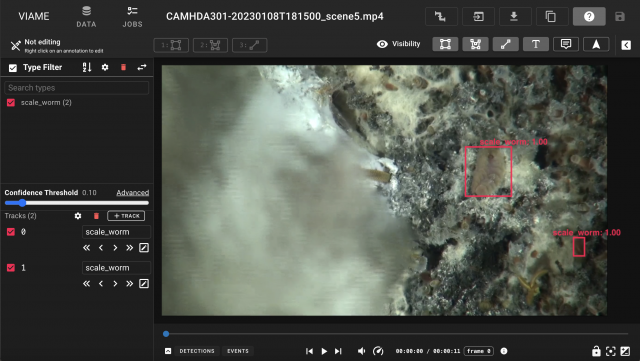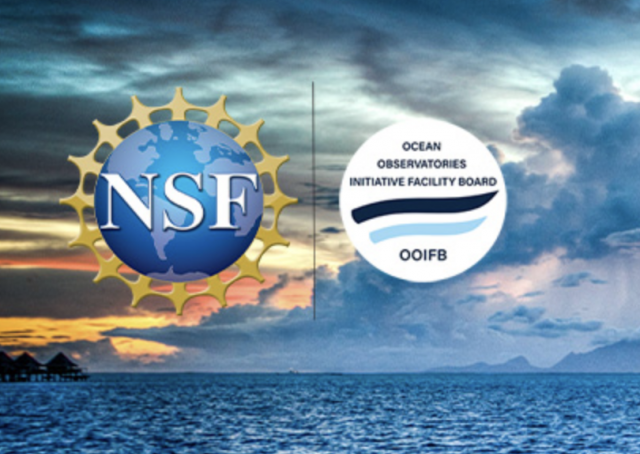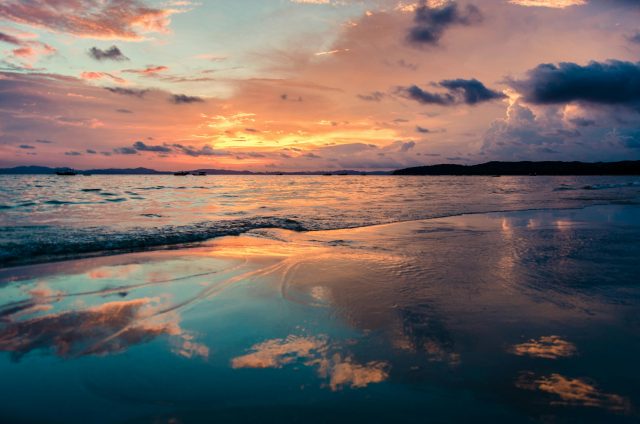News
Open Call for Applications: OOI Facility Board
The U.S. National Science Foundation (NSF) Ocean Observatories Initiative Facility Board (OOIFB) is tasked with representing the science community and users of the NSF Ocean Observatories Initiative (OOI) Facility. The OOIFB works to expand scientific and public awareness of OOI, and ensure that the oceanographic community is kept informed of developments of NSF OOI.
The OOIFB is soliciting applications to fill one membership position that will open as of November 30, 2024. The selected individual will fill one term that will run through November 30, 2027, and then be eligible to serve an additional 3-year term.
Scientists, spanning water column to seafloor expertise, as well as experimentalists, engineers, and modelers, with experience using scientific observing systems, such as the NSF OOI, are encouraged to apply. Familiarity/expertise with Station Papa, the Irminger Sea Array, and/or the Regional Cabled Array are preferred, although not required. All interested applicants will be considered.
The OOIFB holds at least one in-person meeting per year and one web conference each month. The responsibilities of the OOIFB may include, but are not limited to, the following:
- Serving as the prime scientific and technical conduit between the oceanographic community and NSF regarding OOI.
- Examining the accomplishments and work flow of the NSF OOI Operator, in order to provide feedback regarding the NSF OOI Annual Work Plans (AWPs).
- Via workshops, community meetings, and/or other mechanisms, stimulate and engage the user community in order to keep the accomplishments of the NSF OOI at the cutting edge of scientific inquiry and technological innovation.
- Developing and implementing strategies to expand scientific and public awareness of the unique scientific and technological opportunities of the NSF OOI.
- Helping to identify collaborative relationships with potential governmental, industrial, educational, and international partners in the NSF OOI, where appropriate.
- Ensure fair and consistent access to the NSF OOI by all sectors of the user community.
Applications should be submitted to Holly Morin, at the OOIFB Administrative Support Office (holly@ooifb.org), and must include a letter of interest and a CV. The statement of interest should highlight the applicant’s experience using observatory data and have fostered an environment of respect in their research endeavors.
Please note, applications cannot be accepted from individuals affiliated with the NSF OOI Program Facility institutions (Woods Hole Oceanographic Institution, Oregon State University, and the University of Washington), individuals under contract with the NSF OOI Program, and individuals from institutions already represented on the OOIFB (the current list of OOIFB members is available HERE).
Applications are due by November 18, 2024. Applications will be reviewed by the OOIFB, who will give due consideration to the qualifications of applicants, as well as the maintenance of gender, career level, discipline, and regional balance on the OOIFB. For more information about OOIFB and its activities, please visit the website, http://ooifb.org, or contact Dax Soule, OOIFB Chair (Dax.Soule@qc.cuny.edu).
Read MoreOOI Supports Scientific Collaboration at UCAR Annual Meeting
The Ocean Observatories Initiative (OOI) participated in the University Corporation for Atmospheric Research (UCAR) meeting held on October 8-9, 2024 in Boulder, CO. This annual gathering serves as an important platform for collaboration among leading atmospheric and oceanographic research institutions.
At the meeting, OOI Principal Investigator and Senior Scientist Jim Edson discussed with attendees the latest advancements in ocean data collection, spotlighting the role of OOI’s data in critical climate research. He was given the opportunity to describe the OOI and some of the enabled science to a several labs at the National Center for Atmospheric Research (NCAR). These included presentations to members of NCAR’s Climate & Global Dynamics Lab (Ocean Section); Earth Observing Lab; Mesoscale & Microscale Meteorology; Atmospheric Chemistry Observations & Modeling Lab. Jim highlighted efforts to deploy advanced sensors in previously under-sampled areas, such as the Irminger Sea and Gulf of Alaska, addressing major data gaps in these regions. These efforts are essential for gaining a deeper understanding of ocean-atmosphere interactions.
We expect to follow up these meetings with NCAR at the AGU and/or AMS meetings in December and January, respectively. OOI’s partnership with UCAR highlights a shared commitment to integrated climate monitoring. By providing high-quality, real-time ocean data, OOI enables scientists to improve climate models, enhance forecasting precision, and support policy decisions aimed at environmental sustainability.
[caption id="attachment_34970" align="alignnone" width="640"]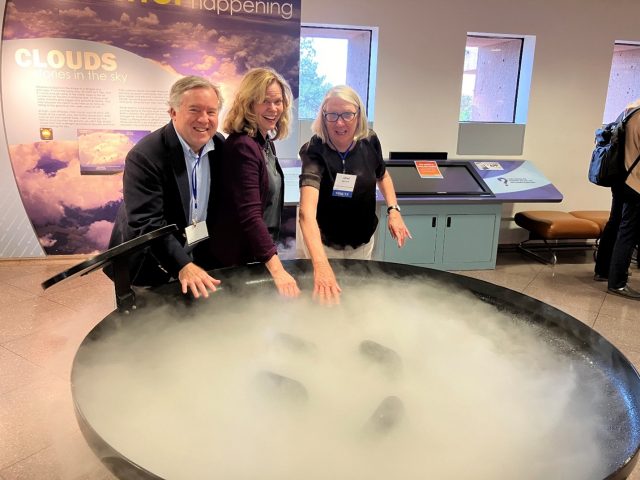 Jim Edson, Carol Anne Clayson (WHOI) and Janet Sprintall (SIO) check out the Cloud Display at the NCAR Mesa Laboratory during the UCAR Reception.[/caption]
Read More
Jim Edson, Carol Anne Clayson (WHOI) and Janet Sprintall (SIO) check out the Cloud Display at the NCAR Mesa Laboratory during the UCAR Reception.[/caption]
Read More UG2 Workshop ’24: A Collaborative Hub for Underwater Glider Innovation
The UG2 Workshop ’24, held from September 10-12 on the University of Michigan campus, brought together leading researchers, industry professionals, and practitioners to advance the capabilities and collaborative efforts of the underwater glider community. National Science Foundation Ocean Observatories Initiative (OOI) attendees included Ed Dever, Principal Investigator of the Northeast Pacific Endurance Array (EA), Peter Brickley, Senior Engineer with the Coastal and Global Scale Nodes (CGSN), and EA glider lead Stuart Pearce and glider tech Jonathan Whitefield. Over the course of three days, OOI participants contributed to in-depth discussions on data management, operational best practices, and emerging technologies, laying the foundation for future advancements in ocean monitoring and glider operations.
Workshop Goals and Objectives
The primary objective of UG2 is to foster a cohesive community that promotes the sharing of glider mission resources within the U.S. and internationally. The 2024 Workshop aimed to:
- Harmonize Glider Efforts: Improve data management and foster partnerships while documenting best practices to enhance collaboration.
- Share New Developments: Highlight recent advancements in sensors, glider technologies, and novel applications.
- Refine Operational Activities: Enhance strategies for sustained ocean observations and explore the impact of glider data on ocean modeling.
- Identify Action Items and Needs: Address communication gaps and improve UG2’s communication platforms for the future.
- Network with Glider Users: Facilitate interactions among U.S. and international glider users to strengthen partnerships.
Key Highlights
The workshop featured several interactive components that fostered deep engagement and collaborative dialogue:
- Liesl Hotaling’s Plenary Talk and Breakout Session: Liesl Hotaling’s plenary talk and subsequent breakout session focused on developing microcredentials for ocean technology professionals. This initiative aims to address workforce needs by creating stackable credentials that recognize core competencies. Her session, co-led with Josh Kohut, invited attendees to discuss the application of these credentials in building capacity for glider maintenance and piloting.
- Data Management Sessions (Day 2): A significant portion of Day 2 was dedicated to addressing challenges in glider data management. Facilitators Jennifer Bowers, Leila Baghdad-Brahim, and Jennifer Sevadjian led discussions on best practices for data collection, registration, and sharing. The sessions provided valuable insights into the U.S. IOOS National Glider Data Assembly Center (DAC) and efforts to standardize glider data handling, ensuring efficient management of multidimensional data. All OOI glider data are routinely reported to the DAC using code developed by Stuart Pearce and others.
- Sustained National Glider Network Session (Day 2): Daniel Rudnick and J. Xavier Prochaska facilitated this session, which emphasized the importance of a sustained glider-based observation network within the Global Ocean Observing System (GOOS). Participants explored the feasibility of creating a coordinated network that integrates coastal and basin-scale observations, building on previous efforts by the Ocean Gliders Boundary Ocean Observing Network (BOON). The OOI’s Endurance Array lines are part of the BOON along the US Pacific coast.
- Poster Presentations: The poster sessions showcased a wide range of research and operational insights. OOI contributed two posters.
- Stuart Pearce et al. presented a poster on “OOI In-Air Oxygen Calibration Adjustments and Improved Oxygen Sensor Mount,” highlighting advancements in sensor calibration for improved accuracy.
- Peter Brickley et al. showcased “OOI Glider Operations in the Mid-Atlantic Bight,” detailing operational strategies and findings from extensive glider deployments in this dynamic region.
Outcomes and Next Steps
The workshop successfully facilitated deep engagement and collaboration, resulting in several key outcomes:
- Enhanced Data Management Practices: The data management sessions provided a comprehensive overview of current challenges and future directions, including early-stage data federation efforts aimed at harmonizing international standards.
- Support for a Sustained Glider Network: The discussions around a national glider network laid the groundwork for future collaboration, emphasizing the need for long-term, high-resolution coastal and deep ocean observations.
- Advancements in Professional Training: The workshop underscored the importance of developing innovative, stackable educational opportunities to build capacity in the blue economy. These efforts aim to enhance workforce skills and provide diverse learning pathways for individuals seeking careers in ocean technology.
[caption id="attachment_34904" align="alignnone" width="640"]
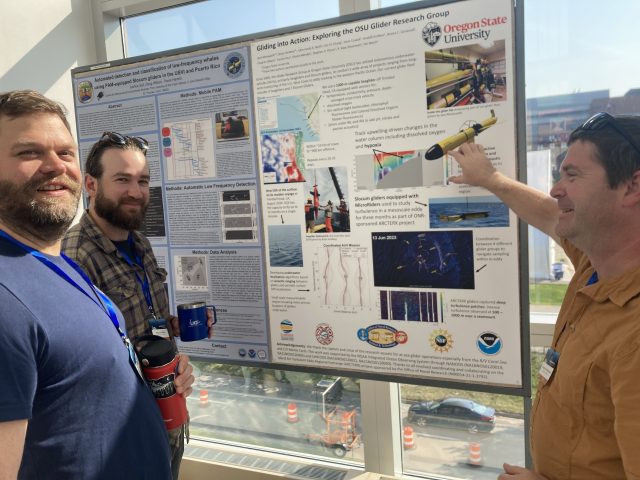 Stuart Pearce (OSU Endurance, left), Brian VerWey (OSU research glider group, center), and Jonathan Whitefield (OSU Endurance, right) pose during discussions around Brian’s poster.[/caption]
Read More
Stuart Pearce (OSU Endurance, left), Brian VerWey (OSU research glider group, center), and Jonathan Whitefield (OSU Endurance, right) pose during discussions around Brian’s poster.[/caption]
Read More Irminger Sea Wind Speed Validation
The Irminger Sea in the North Atlantic is a stormy, windy place. Consequently, it is an area of interest for studying the flux balance of heat, momentum, and biogeochemically important gasses such as CO2. The Ocean Observatories Initiative (OOI) deploys meteorological instruments in the Irminger Sea, as part of the OOI Global Irminger Sea Array, to collect in-situ observations in this relatively undersampled region. The goal is to deliver high-quality, long-term observations to the ocean science community to study these, and many more, questions of interest.
Validating these measurements is an important part of delivering quality data to the ocean science community. This summer, rising senior at California State University – Monterey Bay Aaron Wickware took on the challenge of validating OOI wind measurements in the Irminger Sea. Aaron was a Woods Hole Partnership in Education Program (PEP) scholar. PEP is a program designed primarily for college juniors and seniors from underrepresented groups who want to spend a summer gaining practical experience in marine and environmental science. The program consists of an accredited course in global climate change and a ten-week research project.
At Aaron’s disposal were six different sensors: a Gill Windobserver II two-axis sonic anemometer, R.M. Young Wind Monitor propeller-driven anemometer, and a Gill R3 three-axis sonic anemometer integrated into the direct flux covariance instrument (FDCHP) on the recently deployed Irminger Sea surface mooring; a Gill Windobserver II on the surface mooring to be recovered; and the two Vaisala sonic anemometers located on the ship’s mast. Aaron downloaded all the data, identified the overlapping time periods, calculated the wind speeds from the u-and-v-vector components, adjusted the speeds to a common-height using a community standard bulk flux algorithm (COARE 3.5), and took the 1-hour averages. His resulting comparison demonstrated that the two Gill two-axis sonic anemometers under-reported wind at speeds greater than 8 m/s. His workflow and analysis code are accessible on his GitHub page at https://github.com/Aaron-Wickware/ooicgsn-wind-validation.
Aaron’s results are part of a broader OOI Data Team investigation into the accuracy of buoy-based sonic anemometer wind measurements. This work is being followed up by similar sensor cross-comparisons at other mooring arrays. The results will be incorporated into a report to facilitate the use of data from the OOI-deployed buoy-based anemometers.
[caption id="attachment_34892" align="alignnone" width="493"] Figure 1. Comparison of hourly-averaged wind speeds with standard deviations from the six available wind sensors all operating at the same time at the OOI Global Irminger Sea Array.[/caption]
Read More
Figure 1. Comparison of hourly-averaged wind speeds with standard deviations from the six available wind sensors all operating at the same time at the OOI Global Irminger Sea Array.[/caption]
Read More Connecting Science and Community: Key Insights from the OOIFB Pioneer MAB Workshop
The Coastal Pioneer Southern Mid-Atlantic Bight (MAB) Array Community Workshop, held from September 10-12, 2024, at Old Dominion University, brought together a diverse group of scientists, educators, and stakeholders to explore the potential of the Pioneer MAB Array in advancing oceanographic research in the region. Funded by the U.S. National Science Foundation (NSF) and dedicated to the memory of Dr. Larry Atkinson, the event organized by the Ocean Observatories Initiative Facilities Board (OOIFB), aimed to highlight the array’s capabilities, evaluate regional research progress, and promote collaboration within the ocean research community.
Workshop Focus and Objectives
The workshop offered an in-depth exploration of the Pioneer MAB Array, showcasing its measurement capabilities and ability to improve our understanding of the Southern Mid-Atlantic Bight’s complex oceanographic processes. Participants reviewed past research, discussed data access, and assessed current knowledge and gaps in the region, guided by insights from local stakeholders to align research priorities with community needs.
Day 1: Setting the Stage for Collaborative Research
The first day began with a dedication to Dr. Larry Atkinson, whose career laid the groundwork for many oceanographic initiatives in the region. The morning sessions featured an overview of NSF funding opportunities, encouraging participants to propose innovative research projects using OOI data.
The OOI presentations showcased the successes of past research and outlined the proposal process for adding instruments to the array. These discussions set the stage for deeper dives into key science themes, such as the dynamics of shelf-slope exchange, biogeochemical cycling, and the impact of extreme events like hurricanes, winter storms and freshwater outflows.
The afternoon was dedicated to breakout sessions, where participants engaged in discussions on specific science themes. These sessions allowed for the exploration of collaborative research ideas and the identification of potential projects that could leverage the capabilities of the Pioneer MAB Array.
Day 2: Harnessing Data for Research and Innovation
The second day focused on data access and utilization, with hands-on demonstrations of the latest OOI data tools. Participants were introduced to the OOI Data Explorer and other data access methods that facilitate the retrieval and analysis of complex oceanographic data. These sessions also highlighted the program’s approach to data quality assurance and control, ensuring that researchers have access to reliable and accurate information.
Breakout sessions offered practical experience with data access through various platforms including Jupyter notebooks. These tools enable researchers to leverage the rich datasets provided by the Pioneer MAB Array for a wide range of projects, from studying physical oceanography and biogeochemistry to investigating ecosystem dynamics and the effects of extreme weather events.
The day concluded with a panel discussion on the use of modeling in interdisciplinary projects, providing insights into how data can be integrated into complex models to better understand ocean processes.
Day 3: Expanding Broader Impacts and Future Directions
The final day of the workshop shifted focus to the broader impacts of using OOI data in educational and community contexts. Panel discussions explored innovative ways to integrate OOI data into K-12 and higher education curriculums, as well as engaging citizen scientists and the fishing community in data collection and its many uses. These sessions highlighted the potential for data-driven outreach and education programs to inspire the next generation of oceanographers and to raise public awareness of ocean science.
Key Takeaways
The workshop highlighted the Pioneer MAB Array’s potential to advance our understanding of the Southern Mid-Atlantic Bight and emphasized the importance of accessible data for researchers, educators, and citizen scientists. It effectively fostered collaboration within the scientific community, paving the way for new research initiatives that will propel scientific progress in the region for years to come.
[caption id="attachment_34869" align="alignnone" width="640"]
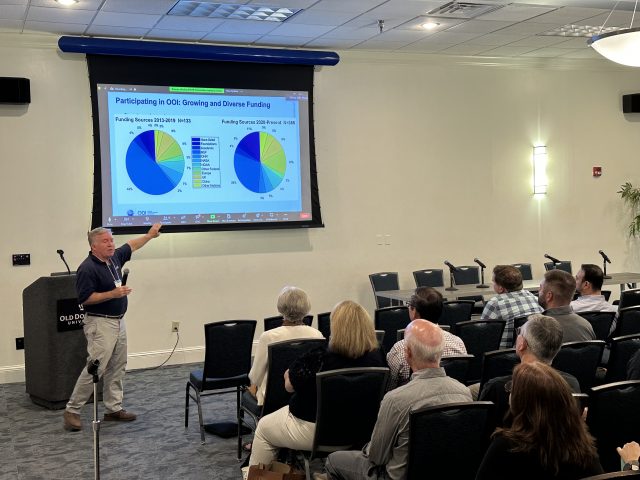 OOI Principal Investigator, James Edson[/caption]
[caption id="attachment_34866" align="alignnone" width="640"]
OOI Principal Investigator, James Edson[/caption]
[caption id="attachment_34866" align="alignnone" width="640"]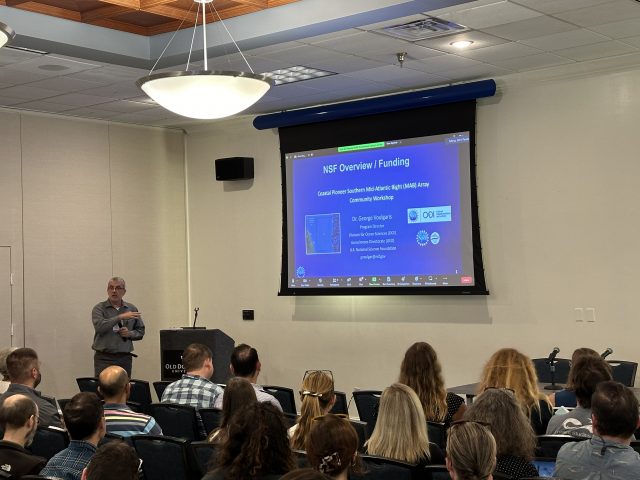 George Voulgaris, NSF OOI Program Director[/caption]
Read More
George Voulgaris, NSF OOI Program Director[/caption]
Read More Deep-Sea Biodiversity: VIAME and OOI JupyterHub Accelerate Research
Off the coast of Oregon, the Axial Seamount on the Juan de Fuca Ridge hosts the ASHES vent field, a site rich in hydrothermal activity and diverse marine life. Principal Investigators, Dax Soule and Karen Bemis, and their teams are leveraging footage from past expeditions, captured by the OOI CamHD video archive, to study species diversity and abundance in this extreme environment.
With hundreds of terabytes of video data available, manual analysis is impractical. To address this, master’s student Julia Sandke and a team of undergraduate researchers are utilizing VIAME (Video and Image Analytics for a Marine Environment), a tool that helps build machine learning datasets by automating the annotation and classification of vent organisms. The goal is to use these datasets to train models that can autonomously analyze species diversity and abundance.
The integration of VIAME’s directories into the OOI JupyterHub environment, along with the addition of Nvidia L40S GPUs, has been a pivotal advancement. Previously, the team faced long delays using the shared VIAME web interface. Now, with dedicated resources in JupyterHub and the enhanced power of GPUs, they can significantly speed up machine learning processes, such as video training and data analysis, which once took days to complete.
This new computational power allows the team to begin unlocking the wealth of data in the CamHD archive, delving deeper into the species diversity around these vents. The long-term goal of the project is to use computer vision and machine learning to develop models that can track species abundance and predict key changes in the ecosystem. For example, these models could forecast where target species may appear after volcanic eruptions at Axial Seamount, providing researchers crucial insights into the shifting biological landscape of hydrothermal vent environments.
[caption id="attachment_34847" align="alignnone" width="640"]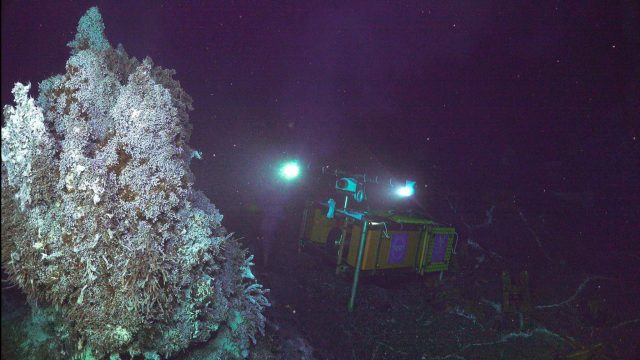 Credit: UW/NSF-OOI/WHOI; J2-1613. V24[/caption]
Read More
Credit: UW/NSF-OOI/WHOI; J2-1613. V24[/caption]
Read More Data Systems Committee – Call for Applications
The Data Systems Committee (DSC) of the Ocean Observatories Initiative Facility Board (OOIFB) was established to help ensure timely and reliable access to high-quality U.S. National Science Foundation (NSF) Ocean Observatories Initiative (OOI) data. The Committee evaluates and recommends improvements to the data services policies and practices of the NSF OOI Facility that will lead to more efficient and effective scientific use of NSF OOI data. The DSC is now soliciting applications to fill one open position. This 3-year appointment will begin October 2024. The selected individual will be eligible to serve a second 3-year term, if fitting.
The DSC holds at least one in-person meeting per year and one web conference each month. Some objectives of the DSC include:
- Keeping abreast of the current state of the NSF OOI cyberinfrastructure and data services with the goal of helping to promote maximum scientific use of NSF OOI data. These efforts will be informed by the FAIR Guiding Principles for scientific data management and stewardship, such that data are: a) Findable, b) Accessible, c) Interoperable, and d) Reusable.
- Encouraging the use of best practices, standards, and naming conventions established by the oceanographic community.
- Engaging with the user community to gauge user needs in regard to NSF OOI data systems, and to facilitate the promotion of a positive user experience.
- Staying current on potential new modes of data service and access, data analysis methodologies, and related technologies that facilitate the use of NSF OOI data.
- Engaging with the NSF OOI Program team regarding the priorities and plans of the NSF OOI cyberinfrastructure groups.
- Making recommendations for data products, usage metrics, and improving the user experience on the OOI Data Explorer, as well as other data service systems employed by the NSF OOI.
Scientists with interests and/or experience using scientific observing systems such as the NSF OOI, as well as those with experience in successfully delivering data from large-scale multi-sensor observing systems to scientific users are encouraged to apply. Interested applicants should submit a letter of interest and accompanying CV to Holly Morin, at the OOIFB Administrative Support Office (holly@ooifb.org), no later than September 17, 2024. The statement of interest should highlight the applicant’s experience with OOI data services and/or with other similar data services. Applicants might also include their experiences with OOI data services and/or a vision for how these might evolve in the future. All applications will be considered. Applications will be reviewed by the DSC members who will give due consideration to the qualifications of applicants, as well as to maintenance of gender, career level, disciplinary, and regional balance on the Committee. For more information about the DSC and its activities, please visit the OOIFB website: http://ooifb.org or contact Jim Potemra, DSC Chair (jimp@hawaii.edu).
Read MoreSummer Science Tours: CGSN Engages Young Environmentalists
The U.S National Science Foundation (NSF) OOI Coastal and Global Scale Nodes (CGSN) Team at WHOI has had a busy summer of talks and tours. With the help of Mashpee Wampanoag WHOI Tribal Liaison and Native Land Conservancy (NLC) founding board officer, Leslie Jonas, CGSN hosted two notable sets of visitors in July and August 2024. The NLC is an Indigenous-led land conservation nonprofit based on Cape Cod that seeks to preserve land for future generations.
As a part of their Preserving Our Homelands (POH) summer science program, a group of students from the Mashpee Wampanoag tribe visited WHOI on 18 July. The POH program provides 6th, 7th, and 8th grade native students with hands-on science experiences in order to deepen their understanding of the environment from a western science perspective and its relationship to tribal culture, and traditional ecological knowledge. Their visit included a stop at the LOSOS facility, where CGSN team members talked about the scientific and technical aspects of the OOI program and provided an opportunity to see ocean observing technology up close. CGSN is grateful to WHOI engineer Ben Weiss and Sea Grant Marine Educator, Grace Simpkins, for organizing the visit and looks forward to ongoing interactions with the POH program.
Before the excitement from the POH tour had died down, a second group of visitors was hosted in early August. The group was made up of about 20 members of the Black, Indigenous, and People of Color (BIPOC) environmental science community. This included the NLC Executive Director, Diana Ruiz, and thirteen members of the Massachusetts Audubon Society and four NLC First Light Fellows. First Light is a paid summer fellowship program for rising Native American conservationists ages 18-25. With mentors from Mass Audubon, Fellows develop individual projects with topics in areas of ecological research, wetland restoration, water quality or land protection that build career skills and advance the NLC’s work. The fellowships combine indigenous culture, environmental sciences, and career development in order to open up career pathways. The four Indigenous Fellows who visited WHOI are studying at Brown, Yale, and Salish Kootenai College and got exposure to real-world instrumentation and engineering tools used to address pressing questions in ocean science research.
Read more about the NLC Fellows.
[caption id="attachment_34683" align="alignnone" width="640"]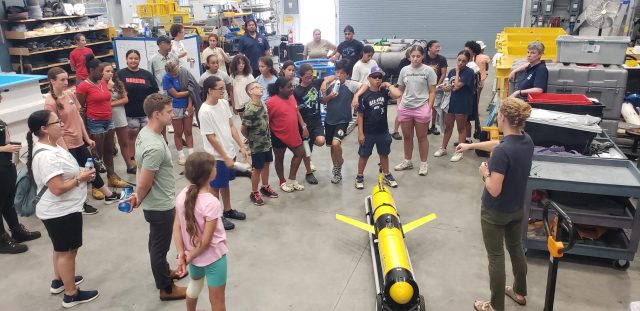 WHOI Senior Engineering Assistant Diana Wickman discusses the operation of an OOI ocean glider with Mashpee Wampanoag POH visitors. Photo credit J. Lund.[/caption]
[caption id="attachment_34684" align="alignnone" width="640"]
WHOI Senior Engineering Assistant Diana Wickman discusses the operation of an OOI ocean glider with Mashpee Wampanoag POH visitors. Photo credit J. Lund.[/caption]
[caption id="attachment_34684" align="alignnone" width="640"]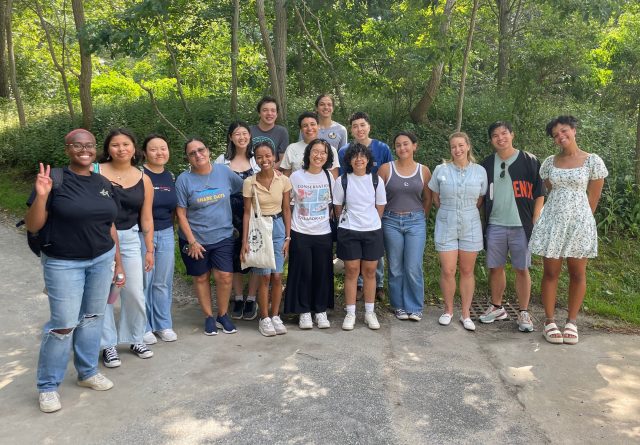 The August group included Native Land Conservancy First Light Fellows and members of the Massachusetts Audubon Society. Photo credit: L. Jonas.[/caption]
Read More
The August group included Native Land Conservancy First Light Fellows and members of the Massachusetts Audubon Society. Photo credit: L. Jonas.[/caption]
Read More CI Compass Fellowship: Empowering Undergraduates Through Hands-On Experience with OOI
The CI Compass Fellowship Program (CICF), funded by the U.S. National Science Foundation (NSF), is a key initiative for NSF CI Compass to provide undergraduate students with hands-on experience in cyberinfrastructure and data-intensive research.
CICF hosts a 12-week virtual Spring Program where students are taught skills they would utilize in a cyberinfrastructure career at an NSF Major of Mid-scale Facility. Students can then apply for the Summer Program, which places a limited number of students in hands-on cyberinfrastructure projects at collaborating NSF Major Facilities.
CI Compass Fellows Cailin, Connor, and Palina, earned internships at the Ocean Observatories Initiative (OOI) this summer.
Nicole Virdone, Project Manager and Director of Outreach for CI Compass, emphasizes that the program’s goal is to offer real-world experience by placing students in internships with major scientific projects like the OOI. “It’s crucial for students to gain practical skills that prepare them for the complexities of professional research environments,” she says.
Through the CI Compass Fellowship, students work directly on projects that support the OOI’s mission, applying their academic knowledge to real-world challenges.
Summer Internships with OOI Included:
- Cailin, a Computer Science major at Villanova University, worked to create a professional dashboard using WordPress, HTML, CSS, and Beaver Builder. The project involved developing a centralized hub where users could access a calendar and view key datasets. By integrating data from Google Sheets via an API, Cailin ensured real-time updates were displayed in tables and charts. The result was a clean, responsive, and functional tool that enhanced the user experience, combining web development with effective data integration.
- Palina, a Computer Science major at the New Jersey Institute of Technology, worked on two projects with OOI. In the first project, she gathered and organized data from various programs, including OOI, NEON, ONC, and AOOS and complied it in Jupyter Notebooks, aligning the data by matching sampling rates and timestamps. In the second project, Palina analyzed how data trends over time related to El Niño and La Niña events allowing her to apply her research and data analysis skills while gaining a deeper understanding of environmental events.
- Connor, a Computer Science major at Ball State University, worked primarily on computer vision projects. One of his main tasks was automating the summarization of over 46,000 videos captured by OOI’s cameras. He developed a method to select 9 key frames from each video to represent its overall content. He created a pipeline to identify blank frames for annotation, helping to streamline and organize the data.
Virdone highlights the program’s success in attracting a diverse group of students, “We’ve seen incredible growth and interest in the program, particularly from underrepresented students in computer science,” she explains. “The impact on these students is clear – they’re gaining experiences that will shape their careers in STEM.”
The CI Compass Fellowship Program not only enriches students’ education but also brings fresh perspectives and technical skills to the OOI. “Mentorship and matching students with the right projects based on their interests and skill levels are key priorities for us,” said Virdone.
Jeffrey Glatstein, Senior Manager of Cyberinfrastructure at OOI emphasizes the impact of the student’s contributions, “The students’ innovative approaches and fresh perspectives have led to tangible impacts in our data management and workflows. It’s a win-win; they gain hands-on experience, and we benefit from their enthusiasm and skill.”
As the CI Compass Fellowship Program continues to grow, it remains an important experience for developing the next generation of scientists and researchers.
Learn more about the CI Compass Fellowship Program by visiting the CI Compass website.
For those interested in the application process of the program, please visit the CI Compass Fellowship Program’s Application process webpage.
[caption id="attachment_34659" align="alignnone" width="480"]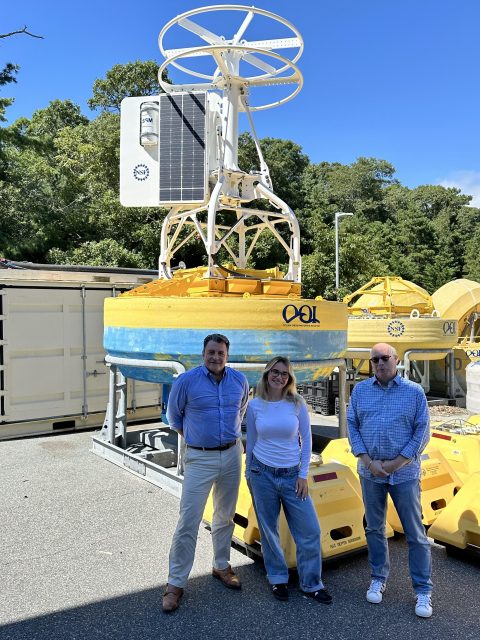 CI Compass Fellow Cailin stands with Matthew Palanza (L), OOI Lead Systems Engineer and Jeffrey Glatstein (R), Senior Manager of Cyberinfrastructure at OOI.[/caption]
[caption id="attachment_34660" align="alignnone" width="640"]
CI Compass Fellow Cailin stands with Matthew Palanza (L), OOI Lead Systems Engineer and Jeffrey Glatstein (R), Senior Manager of Cyberinfrastructure at OOI.[/caption]
[caption id="attachment_34660" align="alignnone" width="640"] Palina stands with the CI team at OOI[/caption]
Read More
Palina stands with the CI team at OOI[/caption]
Read More Where Sea Meets Sky: Children’s School Explores the Ocean’s Impact on Weather at OOI
Students from the Children’s School of Science recently visited the Ocean Observatories Initiative (OOI) at Woods Hole Oceanographic Institution (WHOI) for a field trip led by Dr. James Edson, Senior Scientist and Principal Investigator at OOI.
The visit focused on how the ocean influences weather and climate. Dr. Edson introduced the students to the OOI’s cutting-edge instruments that monitor ocean conditions and explained how ocean currents and temperatures play a crucial role in storms, hurricanes and global weather patterns.
The students participated in hands-on activities, including using anemometers to measure wind speed, and infrared hygrometers to measure evaporation and CO2 exchange giving them a practical understanding of how scientists study the interactions between the ocean and atmosphere. This immersive experience provided a unique opportunity to understand the ocean’s impact on the planet’s climate, sparking curiosity and inspiring future interest in science.
[caption id="attachment_34619" align="alignnone" width="640"]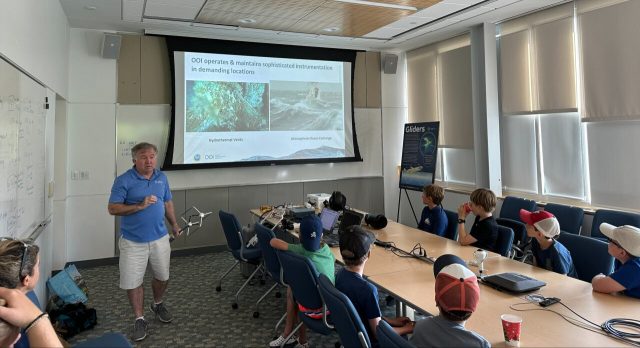 James Edson, Senior Scientist & Principal Investigator[/caption]
Read More
James Edson, Senior Scientist & Principal Investigator[/caption]
Read More 


